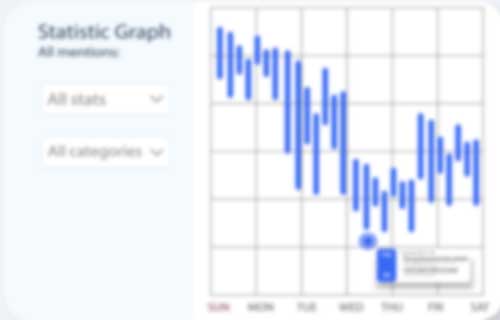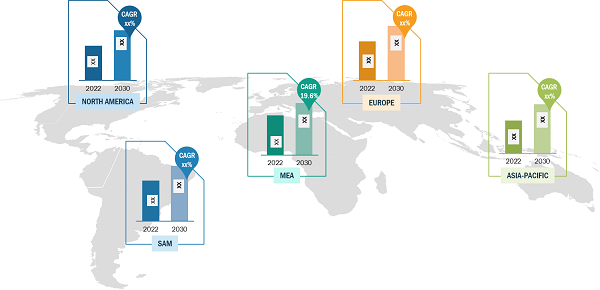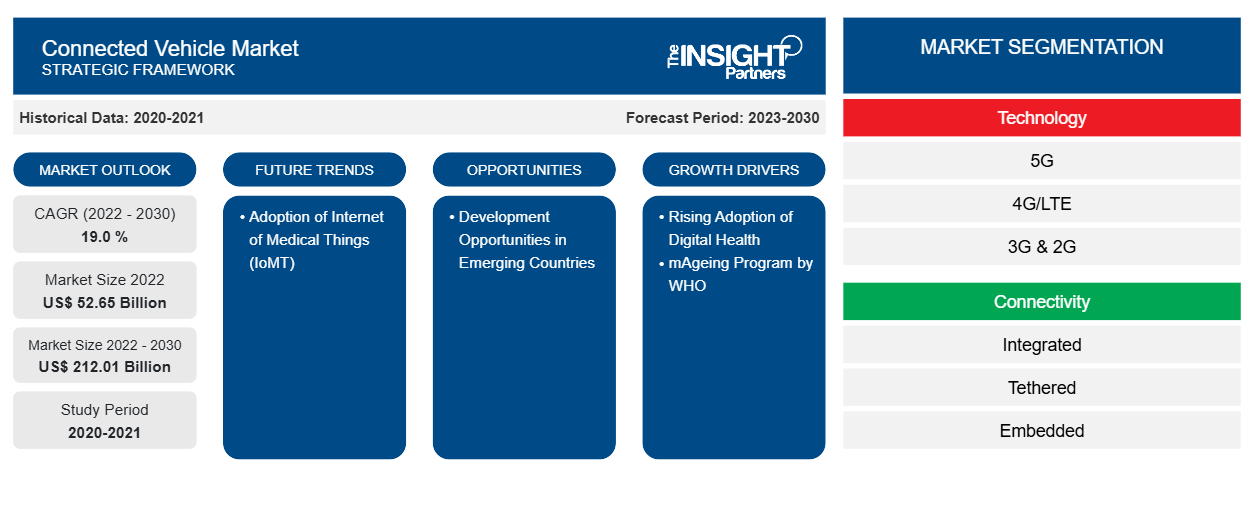[تقرير بحثي] بلغت قيمة سوق المركبات المتصلة 52،649.57 مليون دولار أمريكي في عام 2022 ومن المتوقع أن تنمو بمعدل نمو سنوي مركب قدره 19.0٪ خلال الفترة 2022 - 2030، لتصل إلى 2،12،012.9 مليون دولار أمريكي في عام 2030.
وجهة نظر المحلل:
تنقسم سوق المركبات المتصلة العالمية إلى أمريكا الشمالية وأوروبا وآسيا والمحيط الهادئ والشرق الأوسط وأفريقيا وأمريكا الجنوبية. المركبات المتصلة هي أجهزة أو برامج أو أنظمة تستخدم اتصالات V2X لتحسين السلامة على الطرق أو كفاءة النظام أو التنقل. وهي تستخدم البيانات التي تم جمعها من خلال الاتصالات قصيرة المدى والاتصالات من نظير إلى نظير ومن مركبة إلى مركبة لتحليل ما تفعله المركبات الأخرى والدراجات والمشاة وغيرهم واكتشاف المخاطر المحتملة.
إن التقدم التكنولوجي والتركيز المتزايد على السلامة والراحة من بين العوامل الرئيسية الدافعة لسوق المركبات المتصلة في أمريكا الشمالية. وتتصدر الولايات المتحدة سوق المركبات المتصلة في أمريكا الشمالية. ويؤثر القلق المتزايد بشأن التخفيف من انبعاثات الغازات المسببة للانحباس الحراري والسيطرة على البصمة الكربونية على سوق المركبات المتصلة في أوروبا بشكل إيجابي. كما أن التقدم المتزايد في البنية التحتية للاتصالات والتطور التكنولوجي المتزايد في قطاع السيارات يدفع سوق المركبات المتصلة في أوروبا. وتعد ألمانيا وفرنسا والمملكة المتحدة من بين المساهمين المهمين في سوق المركبات المتصلة في أوروبا.
تعد مبادرات المدن الذكية المتزايدة والاستثمار في تطوير البنية الأساسية وارتفاع الدخل المتاح من العوامل الرئيسية الدافعة لسوق المركبات المتصلة في منطقة آسيا والمحيط الهادئ. تعد الصين واليابان وكوريا الجنوبية والهند من الدول الرئيسية في سوق المركبات المتصلة في منطقة آسيا والمحيط الهادئ.
نظرة عامة على السوق:
لقد شهدت صناعة السيارات تحولاً جوهرياً أثر بشكل إيجابي على سوق السيارات المتصلة في السنوات الأخيرة. تتميز المركبات في هذه الصناعة الديناميكية بقدراتها المتقدمة في مجال الاستشعار والاتصالات والبرمجيات، مما يسمح لها بالاتصال بالإنترنت والمركبات الأخرى والبنية الأساسية والعديد من المنصات الرقمية. أصبحت العديد من الفرص والتطبيقات ممكنة بفضل هذه السيارات المتصلة، بدءًا من ميزات السلامة المحسنة وتحديثات حركة المرور في الوقت الفعلي إلى قدرات القيادة الذاتية والتجارب المخصصة داخل السيارة.
إن أحد القوى الدافعة وراء نمو سوق المركبات المتصلة هو الطلب المتزايد من جانب المستهلكين على الاتصال والراحة. ويتوقع المستهلكون الآن التكامل السلس لهواتفهم الذكية للوصول إلى تطبيقات الملاحة والترفيه ومراقبة مركباتهم والتحكم فيها عن بعد. وعلاوة على ذلك، تستكشف الشركات والصناعات إمكانات الأساطيل المتصلة لتحسين الخدمات اللوجستية وكفاءة الوقود وإدارة المركبات. من ناحية أخرى، تثير المركبات المتصلة مخاوف بشأن خصوصية البيانات ومخاطر الأمن السيبراني؛ ونتيجة لذلك، يواجه السوق قضايا تنظيمية وقضايا تتعلق بالأمن السيبراني. وتعمل الحكومات والشركات على وضع المعايير والقواعد لضمان نشر المركبات المتصلة بشكل آمن.
قم بتخصيص هذا التقرير ليناسب متطلباتك
ستحصل على تخصيص لأي تقرير - مجانًا - بما في ذلك أجزاء من هذا التقرير، أو تحليل على مستوى الدولة، وحزمة بيانات Excel، بالإضافة إلى الاستفادة من العروض والخصومات الرائعة للشركات الناشئة والجامعات
- احصل على أهم اتجاهات السوق الرئيسية لهذا التقرير.ستتضمن هذه العينة المجانية تحليلاً للبيانات، بدءًا من اتجاهات السوق وحتى التقديرات والتوقعات.
محرك السوق:
الطلب المتزايد على نظام مساعدة القيادة
لقد كان لتقدم أنظمة مساعدة السائق المتقدمة (ADAS) تأثير إيجابي على سوق المركبات المتصلة، حيث أعاد تشكيل مشهد السيارات بعدة طرق مهمة. تعد أنظمة مساعدة السائق المتقدمة حافزًا قويًا لزيادة اعتماد تكنولوجيا المركبات المتصلة. تتضمن هذه الأنظمة ميزات مثل مثبت السرعة التكيفي ومراقبة النقطة العمياء ومساعدة ركن السيارة الآلية، والتي حظيت باهتمام كبير لإمكاناتها في تعزيز السلامة على الطرق. ونتيجة لذلك، يقدر المستهلكون ويبحثون بنشاط عن المركبات المجهزة بأنظمة مساعدة السائق المتقدمة. يدفع هذا الارتفاع في الطلب شركات صناعة السيارات إلى دمج ميزات اتصال أكثر تطوراً في سياراتهم. على سبيل المثال، وفقًا للدراسة التي أجرتها جمعية السيارات الأمريكية، يتوقع حوالي 40٪ من المستهلكين في الولايات المتحدة نظام دعم سائق واحد على الأقل. ونتيجة لهذا الطلب، تمتلك البلاد أكثر من 60 مليون مركبة مجهزة بنظام ADAS.
كما تستثمر شركات صناعة السيارات بشكل كبير في بناء شبكات اتصال قوية وعالية السرعة داخل المركبات، وهو عنصر أساسي للتشغيل السلس لأنظمة مساعدة السائق المتقدمة. ويؤدي هذا الاستثمار في البنية الأساسية للاتصال في الوقت نفسه إلى دفع التقدم في سوق المركبات المتصلة الأوسع نطاقًا. على سبيل المثال، في عام 2018، استثمرت بي إم دبليو رأس مال في شركة بلاكمور سينسورز آند أناليتيكس، التي تصنع أجهزة استشعار الليدار ذات الموجة المستمرة المعدلة بالتردد (FMCW) لصناعة السيارات. واستخدمت بلاكمور الاستثمار لتوسيع نطاق إنتاج أجهزة استشعار الليدار ذات الموجة المستمرة المعدلة بالتردد (FMCW) لأنظمة مساعدة السائق المتقدمة (ADAS) وأسواق القيادة الذاتية. بالإضافة إلى ذلك، في عام 2021، دخلت مجموعة فولكس فاجن في شراكة مع مايكروسوفت لتسريع تطوير القيادة الآلية.
التحليل القطاعي:
بناءً على نوع الشبكة، يتم تقسيم المركبات المتصلة إلى 5G و4G/LTE و3G و2G. تعد أنشطة التطوير المستمر، إلى جانب الحاجة المتزايدة إلى اتصالات إنترنت أسرع وأكثر كفاءة، العامل الذي يدعم نمو 4G و5G.
يقدم الجيل الخامس من شبكات الاتصالات تحسينات كبيرة مقارنة بسابقاته. تمت إضافة سرعات أعلى ووقت استجابة أقل وسعة أكبر وموثوقية محسنة، مما يخلق فرص عمل جديدة. تم وضع الأساس لشبكات السيارات المتصلة والذاتية القيادة بشكل أساسي بواسطة 5G. تربط هذه التكنولوجيا المركبات والبنية الأساسأساسأساسية وخدمات الشبكة والدراجات والمشاة. تعد الشعبية المتزايدة للمركبات المحددة بالبرمجيات أحد العوامل الرئيسية التي تسهل هذا التحول. يتم استخدام البرامج لتنفيذ جزء متزايد من وظائف السيارة، والتي قد يتم تحديثها أو تعديلها بمرور الوقت. يتيح هذا التغيير لمصنعي السيارات الأصليين استكمال نماذج الإيرادات الحالية لديهم بنماذج الخدمة القائمة على الاشتراك أو عند الطلب. تعد القدرة على زيادة السلامة طوال دورة حياة السيارة بشكل أكثر فعالية من ذي قبل ميزة أخرى للسيارة المتصلة بـ 5G. مع تزايد شعبية تقنية السيارات المرتبطة، تستخدم بعض شركات صناعة السيارات جمع البيانات وتحليلها لفتح إمكانيات جديدة لصيانة المركبات ومبيعات ما بعد البيع والخدمات.
- ستتضمن هذه العينة المجانية تحليلاً للبيانات، بدءًا من اتجاهات السوق وحتى التقديرات والتوقعات.
التحليل الإقليمي:
تنقسم سوق المركبات المتصلة في أمريكا الشمالية إلى الولايات المتحدة وكندا والمكسيك. وقد حققت صناعة المركبات المتصلة إيرادات عالية في أمريكا الشمالية بسبب التقارب بين العوامل الخاصة بالسوق والتي تخلق بيئة مواتية للنمو والاستثمار. أولاً، تفتخر أمريكا الشمالية بقطاع سيارات ناضج ومتقدم تقنيًا. لقد أدركت شركات تصنيع السيارات الرائدة وشركات التكنولوجيا ومقدمي الخدمات الإمكانات الهائلة للسوق في أمريكا الشمالية واستثمرت وفقًا لذلك في البحث والتطوير ونشر تقنيات المركبات المتصلة. بالإضافة إلى ذلك، كان المشهد التنظيمي في أمريكا الشمالية مؤثرًا في دفع الطلب على نمو سوق المركبات المتصلة. اتخذت الهيئات التنظيمية موقفًا استباقيًا نحو تشجيع دمج ميزات الاتصال في المركبات، مع إدراك إمكانية تحسين السلامة والكفاءة. حفزت هذه المبادرات التنظيمية شركات صناعة السيارات على دمج التقنيات المتصلة في عروض المركبات الخاصة بها.
تتميز قاعدة المستهلكين في أمريكا الشمالية بتفضيل قوي للتكنولوجيا والابتكار. وقد أظهر المستهلكون في المنطقة طلبًا مرتفعًا على المركبات المجهزة بميزات اتصال متقدمة، مثل شبكة Wi-Fi داخل السيارة، والتكامل السلس مع الهواتف الذكية، وأنظمة المعلومات والترفيه المتطورة. وقد ترجم هذا الطلب الذي يحركه المستهلكون إلى أرقام مبيعات وإيرادات أعلى للمركبات المتصلة في السوق.


- ستتضمن هذه العينة المجانية تحليلاً للبيانات، بدءًا من اتجاهات السوق وحتى التقديرات والتوقعات.
تحليل اللاعب الرئيسي:
تعد شركة Harman International، وشركة Visteon Corporation، ومجموعة Vodafone، وشركة Audi AG، وRobert Bosch، وGeneral Motors، وContinental AG، وAT&T، وشركة Denso Corporation، ومجموعة BMW من بين اللاعبين الرئيسيين الذين يعملون في سوق المركبات المتصلة.
التطورات الأخيرة:
تتبنى الشركات في سوق المركبات المتصلة العالمية بشكل كبير الاستراتيجيات غير العضوية والعضوية مثل عمليات الدمج والاستحواذ. وفيما يلي قائمة ببعض التطورات الأخيرة التي قام بها كبار اللاعبين في سوق المركبات المتصلة:
نطاق تقرير المركبات المتصلة
| سمة التقرير | تفاصيل |
|---|---|
| حجم السوق في عام 2022 | 52.65 مليار دولار أمريكي |
| حجم السوق بحلول عام 2030 | 212.01 مليار دولار أمريكي |
| معدل النمو السنوي المركب العالمي (2022 - 2030) | 19.0% |
| البيانات التاريخية | 2020-2021 |
| فترة التنبؤ | 2023-2030 |
| القطاعات المغطاة | حسب التكنولوجيا
|
| المناطق والدول المغطاة | أمريكا الشمالية
|
| قادة السوق وملفات تعريف الشركات الرئيسية |
|
- التحليل التاريخي (سنتان)، سنة الأساس، التوقعات (7 سنوات) مع معدل النمو السنوي المركب
- تحليل PEST و SWOT
- حجم السوق والقيمة / الحجم - عالمي، إقليمي، بلد
- الصناعة والمنافسة
- مجموعة بيانات إكسل
التقارير الحديثة
تقارير ذات صلة
شهادات العملاء
سبب الشراء
- اتخاذ قرارات مدروسة
- فهم ديناميكيات السوق
- تحليل المنافسة
- رؤى العملاء
- توقعات السوق
- تخفيف المخاطر
- التخطيط الاستراتيجي
- مبررات الاستثمار
- تحديد الأسواق الناشئة
- تحسين استراتيجيات التسويق
- تعزيز الكفاءة التشغيلية
- مواكبة التوجهات التنظيمية





















 احصل على عينة مجانية ل - سوق المركبات المتصلة
احصل على عينة مجانية ل - سوق المركبات المتصلة